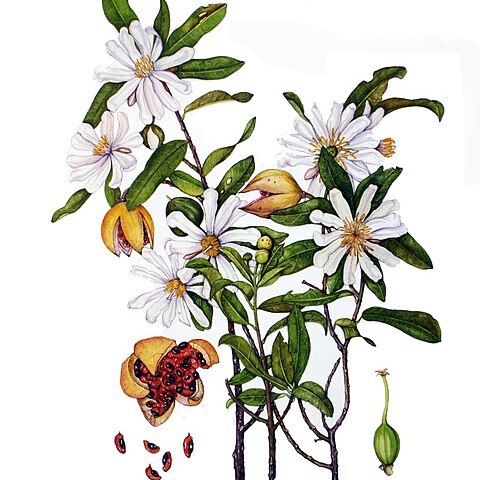A small shrub or tree up to 6 m high. The bark is light grey and rough. The crown has glossy evergreen leaves. The leaves are 2.5-10 cm long and 1.9-5 cm wide. They are oval or sword shaped. They are dark green above and paler underneath. There are 7-11 pairs of side veins which loop along the edge. The veins and midrib are slightly raised. The flowers are large and white. They occur either singly or as a few flowers together. These are in the axils of leaves or at the ends of branches. Flowers are 6 cm across. The fruit are round with a point. They are 5 cm across. They are hard and yellow or orange when ripe. They split into 4 sections showing black seeds with an orange aril.
Leaf-lamina 6–10 x 2–5 cm., elliptic, oblong-elliptic or narrowly obovate, apex obtuse or acute, base rounded or broadly cuneate, margin sometimes somewhat revolute, slightly paler below, pubescent or quite glabrous on both surfaces, lateral nerves in 7–11 pairs, slightly prominent below, looped within the margin; petiole up to c. 1 cm. long, pubescent or glabrous.
Flowers in 1–3-flowered cymes in the axils of the leaves or terminal on the branches; peduncle up to 2 cm. long, pubescent or glabrous; pedicels up to 3.5 cm. long, pubescent or glabrous, with minute, caducous, deltoid bracts at their base.
Ovary ellipsoid, densely hairy, sulcate; style up to 5 mm. long, columnar, somewhat sulcate, glabrous or somewhat hairy at the base; stigmas 4–6, spreading, up to 1 mm. long.
Fruit woody, c. 4 x 2–5 cm., ovoid or ellipsoid, with c. 8 longitudinal ridges, splitting into c. 8 longitudinal segments; style persistent as a hard point.
Stamens very numerous; filaments slender, c. 6 mm. long, glabrous or sparsely pubescent; anthers c. 6 x 1 mm., linear, glabrous, or sparsely pubescent.
Sepals usually 3, c. 1.5 x 1 cm., broadly obovate, very concave, apex rounded, margins membranous, ± densely pubescent outside.
Petals white, 7–12, up to 3.5 x 1.5 cm., oblanceolate to obovate, tapering to the base, with scattered woolly hairs.
Small shrub up to 1.6 m. tall, young branches from densely yellowish-pubescent to quite glabrous.
Seeds many, 9 x 5 mm., ellipsoid, brownish, pilose with a red sticky aril down one side.
From southern Africa, has been grown around Nairobi, e.g. Grahame Bell 3.


